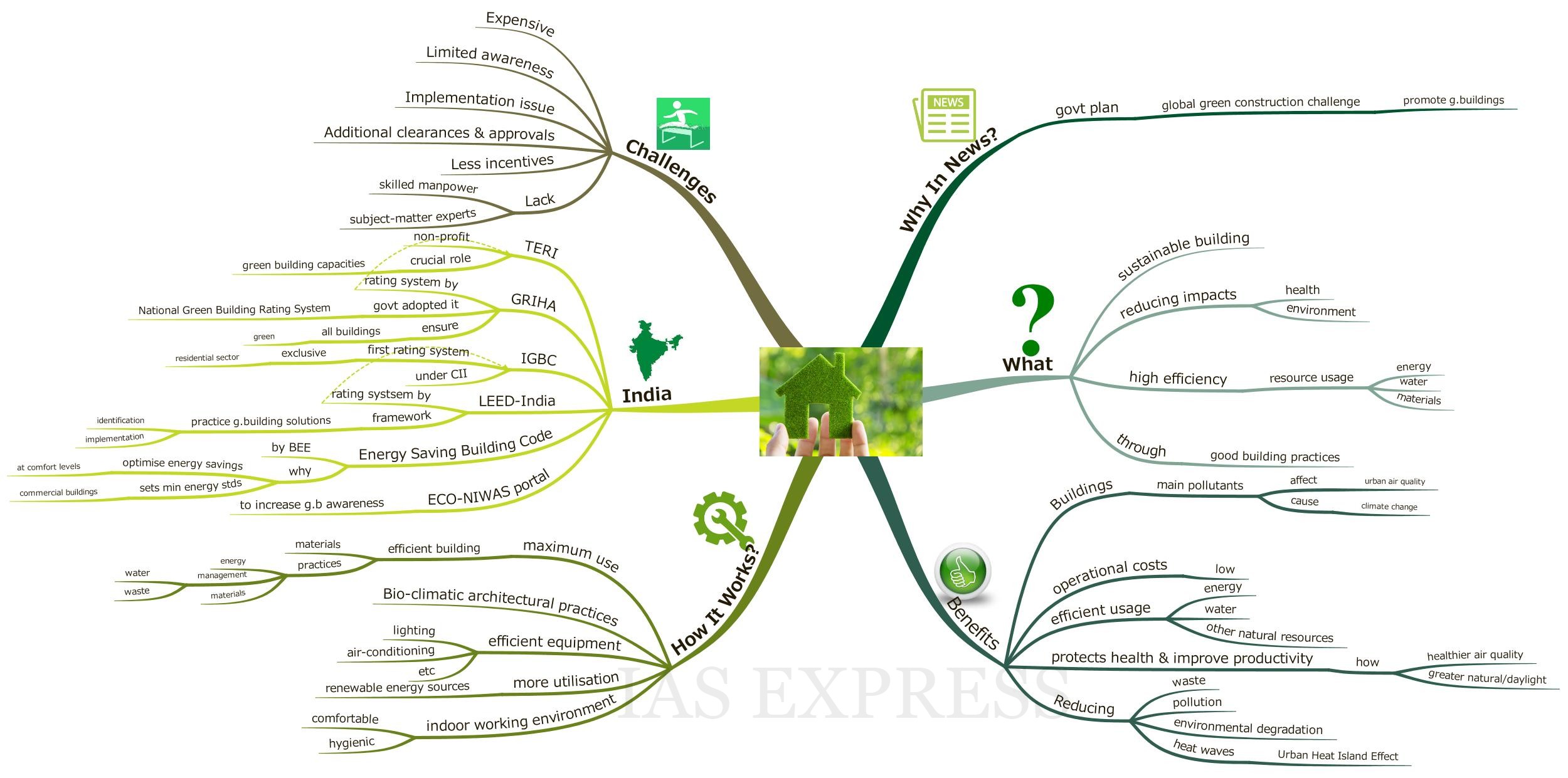Green Building – The Key to Good Health and Environment

From Current Affairs Notes for UPSC » Editorials & In-depths » This topic
IAS EXPRESS Vs UPSC Prelims 2024: 85+ questions reflected
The green buildings in India constitute less than 2%. However, there is a great opportunity to increase that number since about 60% of the country’s infrastructure is yet to be put in place in the next 20 years. Moreover, the government is also planning to launch a global green construction challenge to promote Green buildings in the country. In this article, we will discuss the concept of Green Building, its benefits, implementation challenges and progress in India.
 What is Green Building?
What is Green Building?
Green Building is a sustainable building with high efficiency in resource usage (energy, water, and materials) while reducing impacts on health and environment during its lifecycle through good building practices.
Why Green Buildings? (Benefits)
- Buildings are one of the primary pollutants that affect urban air quality and cause climate change. Promoting green buildings is key to addressing the challenge of environmental conservation and climate change.
- The costs for design and construction of the green building is high, however, the operational costs are low.
- It efficiently utilizes energy, water, and other resources.
- It protects occupant health and improving employee productivity by means of healthier air quality and greater natural/daylight.
- Reducing waste, pollution and environmental degradation.
- It will reduce the Heat waves (caused by climate change) or Urban Heat Island Effect.
How do Green Buildings work?
- Green building involves the maximum use of efficient building materials and practices.
- It optimizes the utilization of on-site sources and sinks by bio-climatic architectural practices.
- It uses minimum energy to power itself by using efficient equipment to meet its lighting, air-conditioning and other needs.
- More utilization of renewable energy sources.
- Efficient waste and water management practices
- Comfortable and hygienic indoor working environment.
India and Green Buildings (important for prelims)
TERI: The Energy and Resources Institute (TERI) (Non-profit) plays a very crucial role in developing green building capacities in the country.
GRIHA: Green Rating for Integrated Habitat Assessment (GRIHA) is a rating system evolved by TERI.
- It was adopted by the government as the National Green Building Rating System for the Country.
- GRIHA aims at ensuring that all types of buildings become green buildings.
- It rates even non-air conditioned buildings as green and puts great emphasis on local as well as traditional construction knowledge.
IGBC: India Green Building Council (IGBC) is the first rating programme exclusively for the residential sector. It is a part of the Confederation of Indian Industries (CII).
LEED-India: Leadership in Energy and Environmental Design (LEED) India has been developed by the Indian Green Building Council (IGBC).
- It is the Green Building rating programme licensed by LEED which is the international certification run by US Green Building Council (USGBC).
- It provides a framework for building owners and operators for identifying and implementing practical green building solutions.
Energy Saving Building Code: Developed by Bureau of Energy Efficiency (BEE) under Ministry of Power.
- To optimize energy savings with the comfort levels for occupants.
- It sets minimum energy standards for commercial buildings.
ECO-NIWAS Portal: Energy Conservation-New Indian Way for Affordable & Sustainable homes) was launched by the government to increase awareness about sustainable building and energy efficient homes in the country. It was developed by BEE.
Also read: The Statue of Unity and the Environmental Issues – Everything you need to know
What are the challenges in its implementation?
Expensive: The main challenge of a green building is to achieve all its benefits at an affordable cost. The equipment and products used in the construction of green buildings are way too expensive when compared to conventional ones.
Limited Awareness: A very large number of Indian users do not know about green buildings and its benefits. Also, the users who know little about green buildings believe it to be an expensive and financially unachievable option.
Implementation issue: Regardless of the fact that India is setting ambitious targets for green building agenda, sadly most of it is not supplemented with proper government rules and regulations to spur growth. There is the inadequacy of proper government rules and regulations to enforce the large-scale implementation of green buildings norms.
Additional clearances & approvals: Builders and developers have to go through a hard time when it comes to approvals, adding to that burden are the list of approvals for green building compliances.
Fewer incentives to encourage adoption: Presently, there are very few incentive plans available to encourage the adoption of green building in India. Also, the ones which exist are not uniform since they differ across various states and cities, due to the diverse governing bodies.
Lack of skilled manpower and subject matter experts: is one of the biggest factors holding back Green Building adoption in India. From policymakers to architects, engineers to contractors and workers, none of the groups possess sufficient knowledge and skills required for green buildings construction.
Way ahead
The issue of environmental degradation is being actively acknowledged in the construction industry and the pledge for Green Buildings as one viable approach to meet environmental, social and economic goals. For India, accelerating Green Building adoption means tuning of norms, better incentive schemes, healthy financial support system and above all, increasing awareness among all stakeholders.
Click here to read Static Environment Mind Map
If you like this post, please share your feedback in the comments section below so that we will upload more posts like this.

